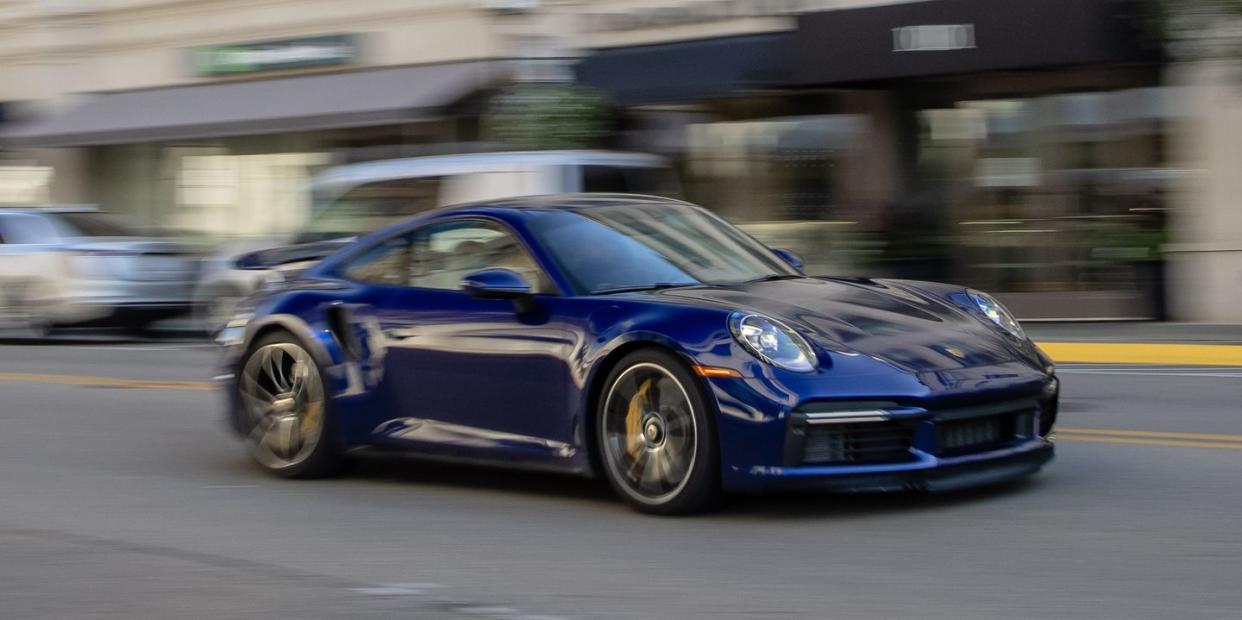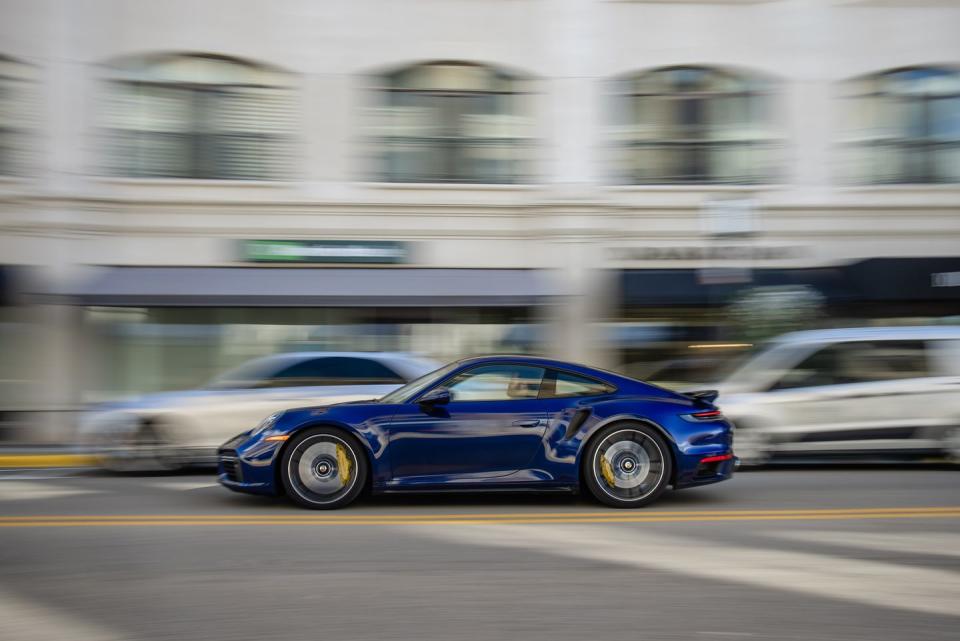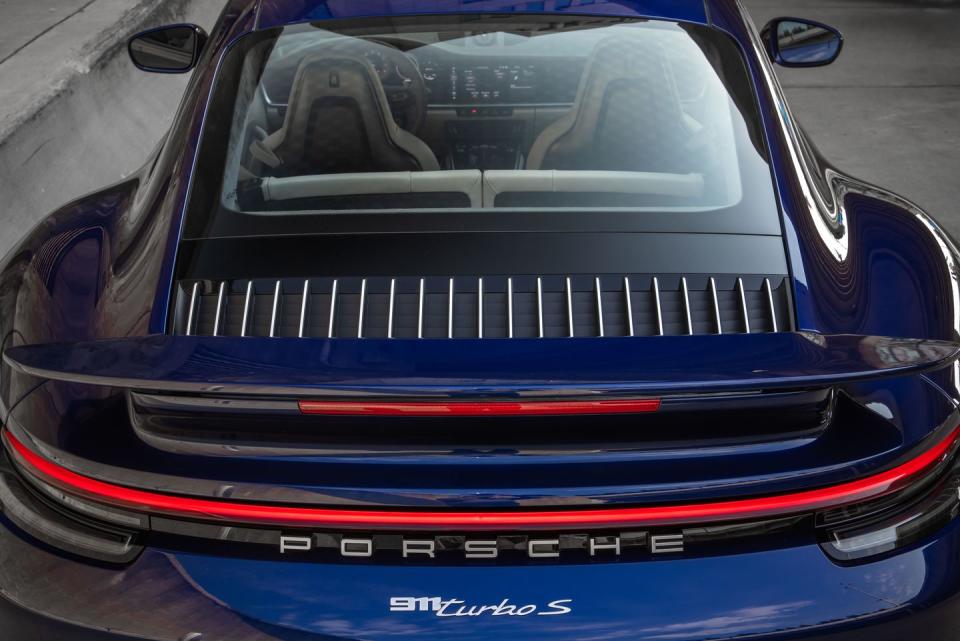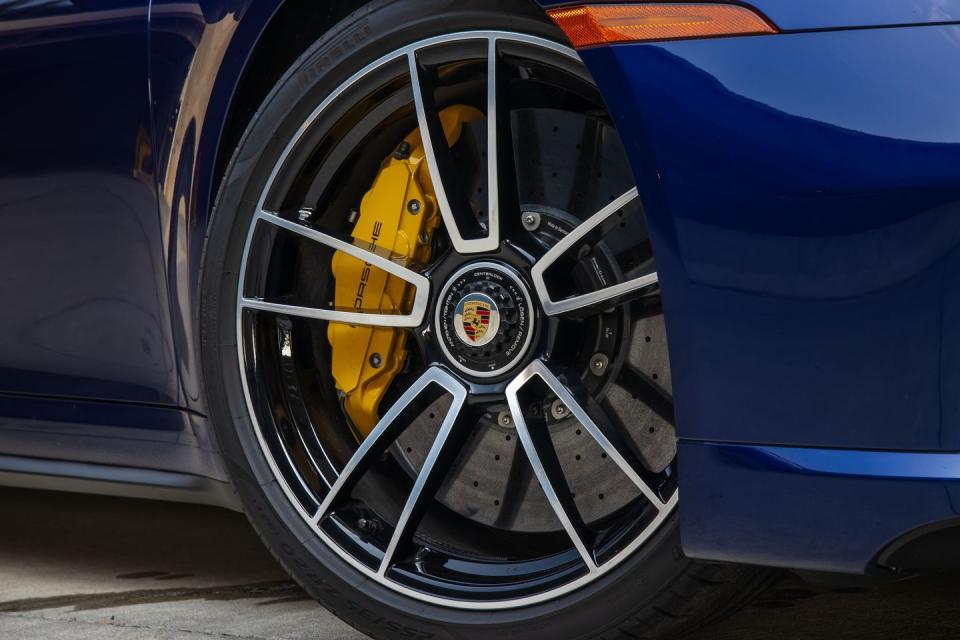Tested: 2021 Porsche 911 Turbo S Reminds Us What Fast Feels Like

12/15/20 UPDATE: This review has been updated with test results.
It's happened before, but it's been a while. You see, C/D testers tend to acclimate to hard acceleration. Seat time in Teslas, Ferraris, Lamborghinis, and AMGs will do that. Our inner ears take so much violent g-force abuse that even monstrously quick begins to feel perfectly normal.
And then a 2021 Porsche 911 Turbo S shows up and hits the reset button. Launch control and 640 horsepower and 590 pound-feet of torque— improvements of 60 horses and 37 pound-feet over the outgoing model—turn up the acceleration. The time to 30 mph is 0.9 seconds, that’s the power to pull out into traffic pretty much as late as you like. Stay in it and 60 mph passes in just 2.2 seconds—making it one of the quickest cars we've ever tested to that mark—with 100 mph coming in 5.3 seconds. It comes so close to dipping into the 9s in the quarter-mile with a 10.1-second run at 137 mph.

To get those times requires engaging launch control. It’s as easy as turning the drive mode knob on the steering wheel to Sport or Sport Plus. Stop the car. Hold the brake with your left foot and hold down the accelerator with the right until the engine revs to 5000 rpm. Look as far down the road as you can before releasing the brake, and whooaa. Keep it floored for 21.4 seconds and you’ll be going 180 mph.
Previously we wrote about being astonished by the Turbo’s acceleration on a short two-lane on-ramp just over the Los Angeles River, east of Hollywood. Pointed down the straight part of the ramp the Turbo S called up 94 mph in about the time that you’d expect to see about 60. In testing, we found that 90 mph takes only 4.3 seconds, which would be a respectable 60-mph time for a sporty car. The Turbo’s acceleration upends expectations and reality. The last time expectations and reality were this tweaked was about a decade ago, and we were behind the wheel of a Bugatti Veyron.

Providing that bump is a heavily revised version of Porsche's twin-turbo flat-six that shares its basic architecture with the 3.0-liter engine in the workaday Carrera and Carrera S models. Although it's a new family of engines, the new Turbo's flat-six has the same bore dimension as before, while a slightly shorter stroke drops its displacement to 3.7 liters, compared with 3.8 on the previous-gen Turbo and Turbo S. But not to worry, as there's more than enough boost to make up for it—22.5 psi, in fact. The intercoolers are 12 percent larger and are fed cooling air more efficiently than before, through both the nostrils in the rear fenders and by two large vents in the rear decklid. The intercoolers do a better job of chilling the pressurized air created by the two new symmetrical turbos.
Larger than before, the new turbos are also identical twins. Well, they're mirror images of each other, the goal being an equal and quicker response from each turbocharger. Both are fed up by a cast exhaust manifold heavily inspired by the ones used in the last-gen GT2 RS. There's really nothing like lag happening here. In our rolling 5-to-60-mph test, a measure that removes an aggressive launch, the new Turbo S scoots to 60 in 3.7 seconds. Even in its weakest moments, this engine is a blink away from burying your shoulder blades into the Turbo S's seat backs. What you hear is up to 91 decibels of the mechanical grit, bellow, and rasp of a flat-six.

We need to slow down, at least a little. The new Turbo S includes standard 16.5-inch carbon-ceramic rotors (0.4-inch larger than before) that are now clamped by 10-piston calipers in front (up from the previous six-piston pinchers). A hard pedal drops the speedometer to reasonable numbers in an instant. Stopping from 70 mph takes a short 139 feet and 100 mph is erased in 284 feet.
The Turbo (capital T) versions of the 911 have always been the widebody, no-neck punks of the 911 world. The new-generation Turbo's body doesn't challenge the order of things. Its front track—the distance between the 255/35R-20 Pirelli P Zero PZ4s—increases by 1.7 inches over the previous Turbo's. But that wider front end is no different than the new Carrera's. In back, where the 315/30R-21 Pirellis live, the body is 1.8 inches wider than a regular 911.

The Turbo's wider stance cuts and holds hard. No drama, just 1.10 g’s worth of cling. Your passengers will be shouting for mercy well before you approach this car's limits.
Our test car arrived with the optional PASM sport suspension that drops the car 0.4-inch on higher-rate springs and recalibrated adaptive dampers. On certain bumps, the chassis shot us out of the saddle like a PBR bull. Yeehaw, then ouch. And it happened in the Normal drive mode, not in the more unyielding Sport or Sport Plus settings. Yet, out in the canyons, the Turbo S doesn't feel abusively harsh. It simply flows from corner to corner, four-wheel steering working its magic, the dampers keeping everything grounded, and the gearbox selecting the right gear before the turn-in into corners.

Like the last 911 Turbo, there's no manual-transmission option. While having that connection with this engine would bring tears of joy to the air-cooled faithful, we have to admit that with the Turbo S's acceleration flinging you back, it might be hard to grab the shifter. All Turbo S models come with an eight-speed dual-clutch automatic that allows you to keep your hands on the wheel.
There's a certain brutality as the blast of an engine turned up to 171 horsepower per liter cranks through the drivetrain and into the road. The tires screech. Passengers screech. Maybe even you screech—at least a little. Bear in mind that the tire squeal happens despite the Turbo S's standard all-wheel-drive system.
We can hear the lawyers now. Do you suffer from heart, back, or neck trouble? High-blood pressure? Have you or a loved one been exposed to a Porsche 911 Turbo S? If so, call this number. Except Porsche probably has better lawyers than most amusement parks. Sign here, here, and initial here. Have fun.
You Might Also Like

 Yahoo News
Yahoo News 
